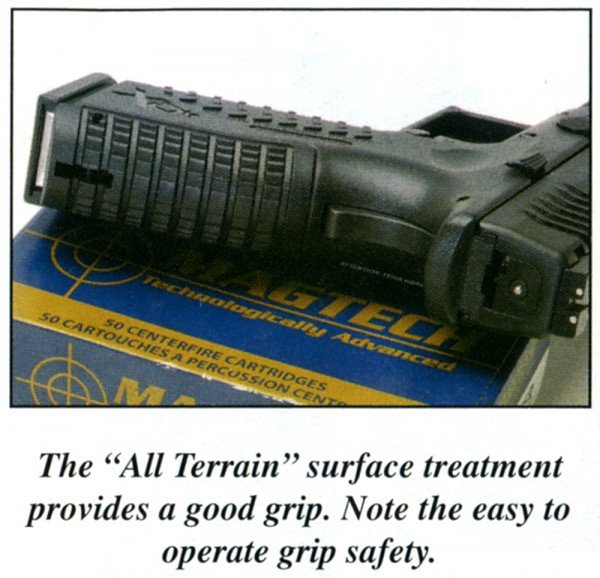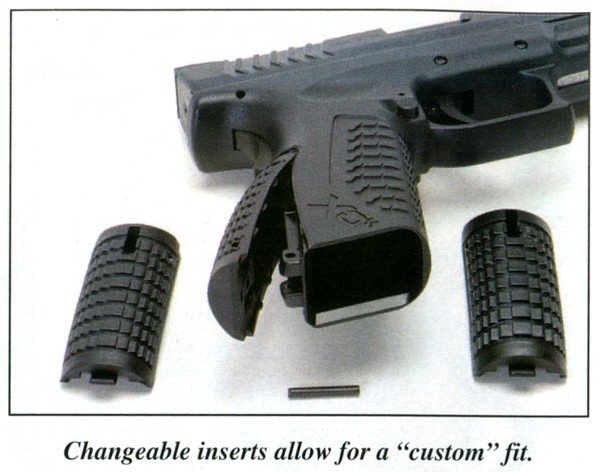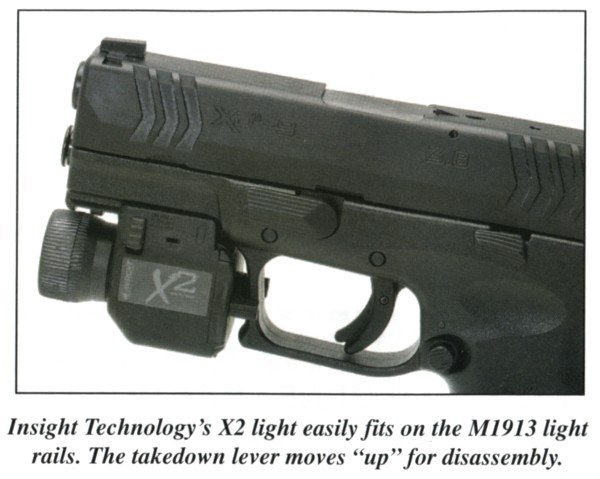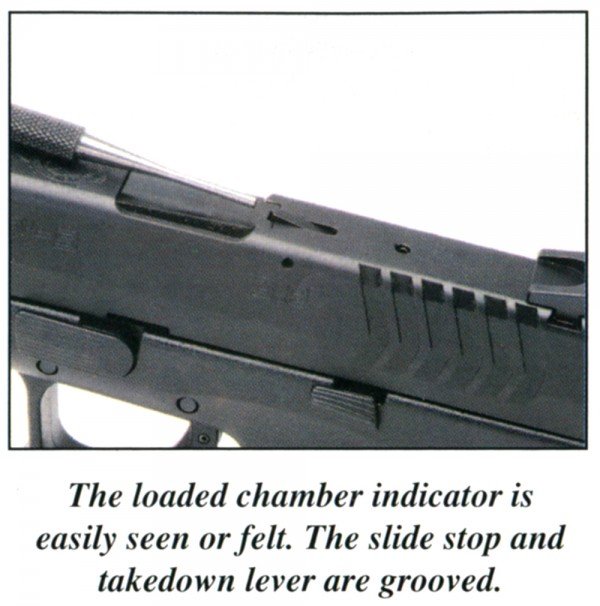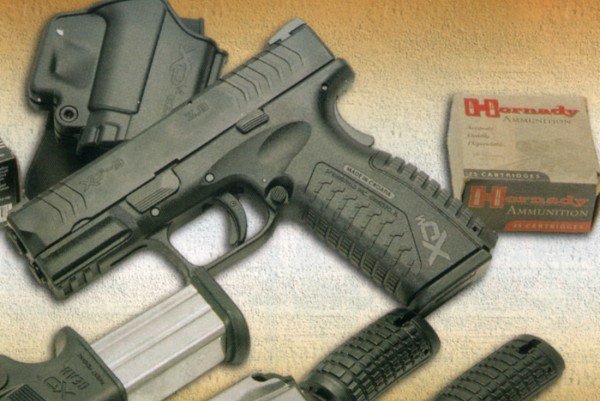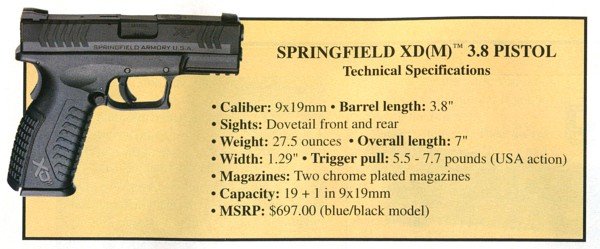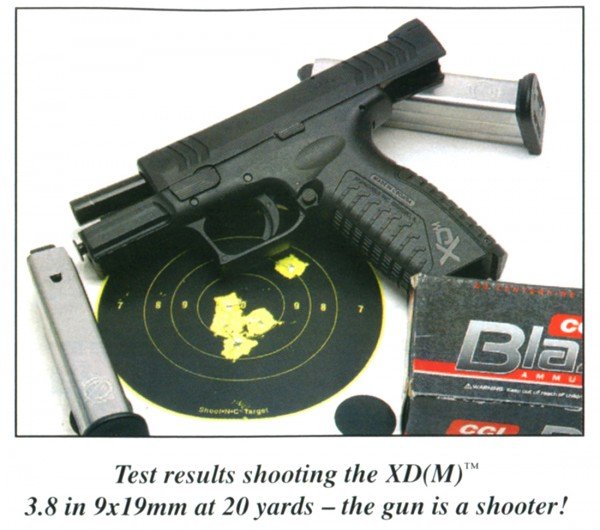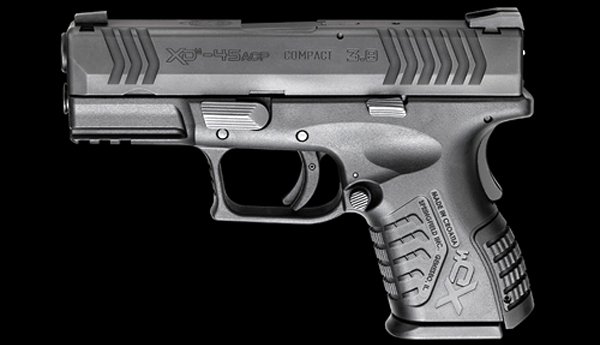
The Springfield XD (X-Treme Duty) pistol continues to enjoy widespread acceptance among lawmen and legally armed civilians, as it offers a good combination of features most desired by the self-defense-minded. Along the way, the original standard full-size pistol has continued to evolve, going up in calibers from 9x19mm to .40S&W, then to .45ACP and then to .357SIG. XD slides have gotten both longer and shorter, with frames shortening — and becoming thicker thanks to changeable frame inserts.
Easy and More Comfortable
This latest model — the XD(M) (More) 3.8— is the short slide on a standard frame version. The advantage of a short slide and barrel on a full-size frame is that a shorter slide/barrel makes for an easier draw, particularly for short waisted users. The short slide also lends itself to more comfortable appendix carry, meaning no stomach “stab” due to the gun’s slide length. Retaining the full- size frame also keeps the user well supplied with ammo, as the full-size magazine in 9x19mm has the large capacity of 19 rounds.
Curiously, on this last point, while I was picking up this sample from my FFL dealer, someone mentioned that a recent female purchaser of this model had only one complaint about the XD(M) 3.8: Due to this large amount of ammunition in the magazine, the gun was a bit heavy! (And, no, to the best of my knowledge, no one was rude or dumb enough to point out that this could be “fixed” by simply loading the magazine with less ammunition.)
The Basics
The XD(M) 3.8 is a polymer and steel, striker fired, single-action pistol manufactured by IM Metal, Croatia, and imported by Springfield Armory. The U.S. versions incorporate many features requested by users which definitely improve and upgrade the original version of the XD. However, the XD(M) 3.8 still reflects its European heritage of serial numbering the slide, barrel and frame (we don’t normally do that here in the U.S.), in addition to having this number on a metal insert found in the lower face of the frame’s dustcover (its U.S. location).
The XD(M) 3.8 differs from the full-size XD(M) in that it has a 3.8″ barrel, while the base gun has a 4.5″ barrel (and slide). The XD(M) 3.8 is chambered for 9x19mm or .40S&W, with the aforementioned magazine capacity of 19 rounds in 9xI9mm and 16 rounds for the .40S&W.
Features
The all steel. machined slide is sharpish, but not rectangular: at its lower edge, its body measures 1.15″ in width, enlarging upward to .335″ at the center line and then enlarging again to .915″ at the top of the slide. Three wide front and five rear grasping grooves offer a good grip with their
forward opening diagonal shape. The sights are dovetailed and windage adjustable both front and rear and use a three white dot sighting system. Aftermarket sights are available.
At the top center rear of the ejection port, there is a loaded chamber indicator which is a lever centered top and rear of the wide ejection port window and extending into the top rear of the barrel chamber. Chambering a round forces this indicator up above the slide where it can be felt or seen. The firing pin striker, when retracted as the side is cycled, protrudes from the slide’s steel back plate and it, too, can be seen or felt. While not indicative of a cartridge being present or not, it does serve to throw up a warning flag to look further. The extractor is internal and is similar in configuration to that of a 1911.
The barrel locks up with the top rear portion of it fitting into the large ejection port. The dual recoil springs are captive On a metal guide rod and follow the design used in the compact GLOCK®s and Para- Ordnance guns, to name but two.
The front flat portion of the recoil spring guide slightly protrudes from the face of the slide, creating a muzzle protector which could, in some circumstances, prevent damage to the muzzle if the gun were dropped. This “stand off— feature could also keep the gun from being pushed out of battery when the muzzle is shoved against something hard.
Drop Safety
A polymer safety lever is centered in the wide, grooved, metal trigger. This is a “drop” safety. In action, the center mounted lever must be pressed rearward to allow the trigger to be moved. If the gun were to be dropped on its muzzle without this device, it is possible that this abrupt jarring of the gun, thanks to inertia, could cause the trigger to be cycled without being touched. Springfield calls this the Ultra Safety Assurance (USA) trigger safety. In actual use, the trigger moves about .50″ in take-up before encountering resistance of (measured here) six pounds. When pressure is applied to the trigger, the trigger bar moves the sear down and away from the firing pin which had been previously captured by the sear when the slide was retracted.
While technically single-action, the feel of the trigger is more like a double-action, requiring long movement of it to fire. Factory specifications call for trigger pull weights from 5.5 to seven pounds which puts this sample within the designated weight range.
The other controls are equally simple. The large, grooved, takedown lever is on the left forward section of the frame. To operate this for disassembly, the front portion of the lever is moved up through a corresponding relief cut in the slide. The metal slide stop on the upper left center of the frame is slightly protected by a molded ledge beneath it. The round and circularly grooved magazine catch is ambidextrous and, thanks to the deep thumb swell on both sides of the frame, this equally ambidextrous part is very “reachable” without some, if any, grip shifting.
The thumb swells mentioned are quite comfortable when gripping the gun, as they provide a natural location for the user’s thumb and also the trigger finger. These are done on imports to help such pistols meet federal import laws which mandate a handgun must be for sporting purposes. Each enhancement which speaks to these goals increases the gun’s qualifying via “points” for import as determined by the Bureau of Alcohol, Tobacco, Firearms and Explosives. The nicely grooved trigger face found on the XD(M) also earns such points, since that makes it a “target” trigger.
Gripping Surface
The surface treatment of the frame is identified by Springfield Armory as the “All Terrain” gripping surface. It covers most of the gripping area and does give good hand adhesion without discomfort, and its grip angle is more 1911 than, say, a GLOCK. The recurved trigger guard has shallow grooves on its forward face and is large enough to allow firing while wearing single layer gloves.
The dustcover has a triple position Picatinny rail offering a more user-friendly positioning of tactical lights or lasers. I installed Insight Technology’s M2 light which went on and came off without difficulty. The slide rides on four rails. Two of them are in the steel locking block, with two more at the rear, molded into the polymer frame.
In keeping with current trends, the lower back strap is changeable with the three provided inserts (S. M and L) by driving out a hollow pin at the lower rear of the frame.
The two chrome plated, steel body magazines supplied with each gun have a polymer follower, inner locking plate and external base plate. Also furnished are a magazine loader, a polymer paddle holster and dual magazine carrier. The loading device can be handily attached to the dual magazine pouch which has a rail on either side of it for this purpose. Of course, this is also a good location to keep your gun light since the belt slide design holster will not accept the gun with a light mounted. The holster is tension adjustable by an Allen screw.
Comes Apart Easily
The gun’s disassembly is easy, but there are items which must be noted. The magazine must be removed and the chamber checked to insure the gun is empty. To do this, though, the grip safety must be depressed, since it also locks the slide in its closed position. The manipulation to do this to disassemble the gun was awkward for me at first, as I have a habit of turning the gun to the left in my hand so that I can push up more directly on the slide stop. But, after doing this the “right way” a few times, it became easy and habitual for me.
Next, after you have the slide locked back and the takedown lever has been raised, the slide assembly can be removed forward and off the frame. It is not necessary to have the striker decocked nor to remove the magazine to remove the slide.
Range Results
Over three occasions of firing this sample, the XD(M) 3.8 worked well without malfunction and was consistently accurate. It did help that the instruction manual states that “…Springfield Armory pistols are designed to use the ‘six o’clock’ sight picture at 25 yards. However, some pistols may shoot ‘point-of-aim’ at 25 yards depending on shooter and ammunition.” The manual gives no target dimensions, but I found that by taking a six o’clock hold on the 5.5″ Shoot-N-C bull’s eye at 25 yards, my shots impacted center, so, for my eyes, the gun shoots about two inches high at this distance.
The XD 9mm worked equally well with 115-, 124- and 147-grain bullet weights in both standard and +P velocity loads from Black Hills, Remington, Winchester, Hornady, and CorBon. This XD, as has been the case with the others I’ve shot, is a pleasure to shoot in this caliber, having soft felt recoil and the “All Terrain” molding did help me hold the gun well in my hand on rapid-fire strings.
Final Thought
In review, the gun worked fine and the holster and magazine combo were functional, comfortable and concealed well. All in all, it’s a nice package which comes in a sturdy plastic carrying case.
About the Author: Upon receiving his BS degree from Carnegie Tech and completing service as a Special Agent in U.S. Army Intelligence, Walt Rauch was a Special Agent with the U.S. Secret Service and an Investigator with the Warrant Unit, First Judicial District, PA.
Rauch is also a writer and lecturer in the firearms field. He is published regularly in national and international publications.
